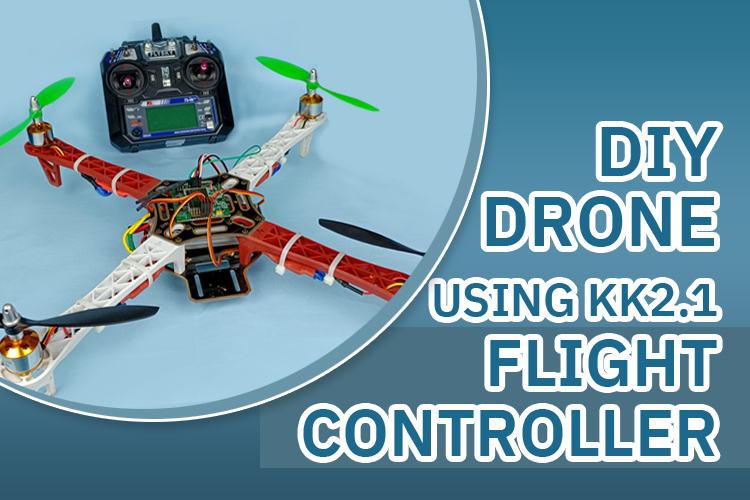
In Part-1 of this tutorial, we have seen how to assemble and set up the quadcopter. In this tutorial, we are going to fly our quadcopter and we will discuss the challenges we have faced during fly. Before flying a quadcopter, you have to check UAV guidelines issued by the local authorities in your area. We are going to use the KK2.1.5 flight controller for our quadcopter and we have also explained the difference between KK2.1 and KK2.1.5 flight controller in this tutorial later. Here, we are going to use the FS-i6 transmitter and FS-iA6B receiver to fly our quadcopter. You can follow our article Everything you need to know about the FLYSKY FS-i6 Transmitter and Receiver for Effortless Drone Control to understand the functionalities of the FS-i6 transmitter and receiver.
Prerequisites
You have to assemble your quadcopter according to Part-1 of this tutorial. You should use the propeller’s guard and landing gear for the safety of propellers and you have to set proper P&I values in the PI editor. Components like batteries, transmitters, and flight controllers should be placed at proper position otherwise quadcopter will become unstable. You have to fly your quadcopter at the grassy field if you are a beginner or you don’t have much flight experience. In Part-1 we have designed quadcopter using a KK2.1.5 flight controller. Firstly, you should know the difference between KK2.1.5 and KK2.1 flight controllers.
Difference between KK2.1.5 and KK2.1 flight controller
There is a huge difference between the two flight controllers. Both have different features and stability and KK2.1.5 provides more stability as compared to KK2.1. You can differentiate both by:
- Both the flight controllers are very similar in appearance but we can differentiate by it by button’s color. The button which is in KK2.1.5 is of red color and the button in KK2.1 is of black color.
- In KK2.1.5 we can connect tricopter’s lead to either M4 or M7 but in KK2.1 we can connect tricopter’s lead to M4 only.
- KK 2.1.5 has a big P&I value in PI editor and KK2.1 have a small P&I value in PI editor so KK2.1.5 provides a smooth flight to drone but KK2.1 flight controller turns very fast.
- The self-level setting is one of the most important settings for any flight controller, by using the self-level setting we can self-balance our drone which increases the stability of the drone. We have only stick and aux options in self-level settings of KK2.1 flight controller but in KK2.1.5 we have more options like a stick, aux, always, and none.
- We cannot control the servo motor (for gimbal) in KK2.1 flight controller but in KK2.1.5 flight controller, we can control 2 servo motors.
In the below image, you can see the left one is KK2.1.5 and the right one is the KK2.1 flight controller. After knowing the difference between both the controllers now, we are going to set up the KK2.1.5 flight controller.
Setup the KK2.1.5 flight Controller
Methods to set up KK2.1.5 and KK2.1 flight controllers are not the same. Here, we are going to set up the KK2.1.5 flight controller, you cannot use this method for KK2.1. Firstly, make all the proper connections according to part - 1 of this tutorial build your own Drone using KK2.1.5 Flight Controller – From Selecting Right Components to First Flight (Part-1). Now give power to the flight controllers through ESCs. Follow the below steps to set up a quadcopter.
Step-1 Press the S4 button (Menu) and go to the factory reset option and select it then choose the Yes option. Now, your flight controller has been reset. Now press the back option and select quadcopter X mode. Now press the next button and check the direction of all propellers then press the back button.
Step-2 Press the S4 button (menu) and go to acc calibration option and select it and then press continue and wait for 5 seconds. Your acc calibration has been completed, now press continue. Keep your quadcopter on a flat surface before doing acc calibration otherwise drone flight will not be stable.
Step-3 Press the S4 button (menu) and go to PI editor and keep the P&I values as it is.
Step-4 Press the S4 button (menu) and select the Receiver Test option. Now turn on your transmitter and make all values (aileron, elevator, throttle, Rudder) zero by using Trims button in transmitter.
Step-5 Now go to Misc. Setting and set Alarm 1/10 volts value 105. If you don’t know why we choose this value 105 then see part-1 of this tutorial.
Step-6 Now go to the mode setting and select option AUX. Now you should do ESC calibration after setup the KK2.1.5 flight controller. So first turn the transmitter with the throttle to a minimum then move throttle to maximum and keep pressing S1 and S4 switches and then connect the battery to the quadcopter, now we will get two beep sounds and we will put the throttle down which leads to a single beep sound. With this, the calibration process gets over.

Now keep the throttle on the left-hand side and you will see ARMED text on your KK2.1.5 flight controller display. ARMED means your quadcopter is ready to fly. In the below video, you can see quadcopter flight at different stages. Hope you enjoyed the project and learned something useful. If you have any questions, please leave them in the comment section below or use our forum to start a discussion on this.






